To create perfectly balanced herbal teas, start by understanding your dosha: Vata, Pitta, or Kapha. This knowledge guides your herb selection. Choose complementary flavors—sweet, sour, bitter, pungent, and astringent—while considering seasonal availability. Master infusion techniques for ideal flavor extraction, using the right water temperature and steeping time for each herb type. Adjust your herb ratios to suit your taste and blend purpose. Finally, personalize your tea by experimenting with different combinations that align with your health goals. These principles form the backbone of Ayurvedic tea crafting, paving the way for delicious, harmonious brews that enhance your well-being.
Understanding Doshas
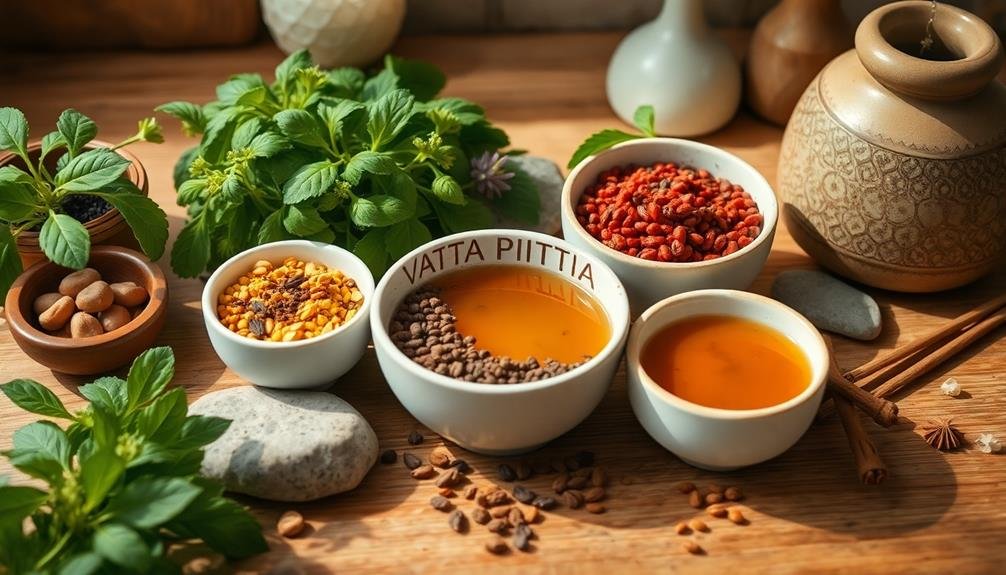
Understanding doshas is essential for anyone looking to harness the healing power of herbal teas in Ayurveda. The doshas—Vata, Pitta, and Kapha—represent unique combinations of the five elements: earth, water, fire, air, and space. Each dosha influences your physical and emotional health, so knowing your main dosha can guide you in choosing the right herbal teas.
If you're mainly Vata, you might experience dryness and anxiety. Herbal teas with warming, grounding ingredients like ginger and cinnamon can help balance your energy.
For those with a Pitta constitution, which may lead to heat and irritability, cooling herbs like mint and chamomile are excellent choices.
Selecting Herbs Wisely
When selecting herbs for your tea, you need to reflect on your dosha type to guarantee harmony in your body.
It's also important to choose herbs that align with the season and balance the flavors in your blend.
Understanding Dosha Types
Your dosha type plays an essential role in selecting the right herbs for your tea. In Ayurveda, there are three primary doshas: Vata, Pitta, and Kapha. Each dosha embodies unique qualities and characteristics, influencing your physical and mental well-being. Knowing your dosha helps you choose herbs that align with your body's needs.
If you have a Vata dosha, you'll want to focus on warming and grounding herbs like ginger, cinnamon, or licorice. These herbs can help balance the light, dry, and cool qualities of Vata.
For Pitta types, cooling and soothing herbs, such as peppermint, chamomile, and fennel, work wonders to counteract Pitta's fiery nature.
Seasonal Herb Selection
Selecting herbs according to the seasons can greatly enhance the benefits of your herbal teas. When you align your herb choices with the natural rhythms of the environment, you help support your body's needs.
In spring, for instance, consider using fresh herbs like peppermint and nettle. They help cleanse the body and boost energy as you shift out of winter.
During the warm summer months, you might want to focus on cooling herbs like hibiscus and lemon balm. These can help balance heat and promote hydration.
As autumn arrives, warming herbs like ginger and cinnamon become beneficial, helping to strengthen your immune system as temperatures drop.
In winter, embrace robust herbs such as thyme and eucalyptus, which can support respiratory health and provide warmth.
Flavor Profile Balance
Balancing the flavor profiles of your herbal teas is key to creating a satisfying and harmonious experience. When selecting herbs, consider the primary tastes in Ayurveda: sweet, sour, salty, bitter, pungent, and astringent. Each herb contributes its unique flavor, and understanding this can help you create a well-rounded blend.
Start with a base herb that provides a pleasant aroma and taste. Chamomile, for example, offers sweetness and calming properties. Next, incorporate herbs that bring complexity; ginger adds warmth and spice, while peppermint introduces a revitalizing note. Aim for a balance between sweet and spicy to avoid overwhelming the palate.
Don't forget about bitter or astringent herbs, like dandelion or hibiscus, which can enhance digestion and add depth. A sprinkle of citrus peel can uplift the blend, adding brightness and balance.
Balancing Flavors
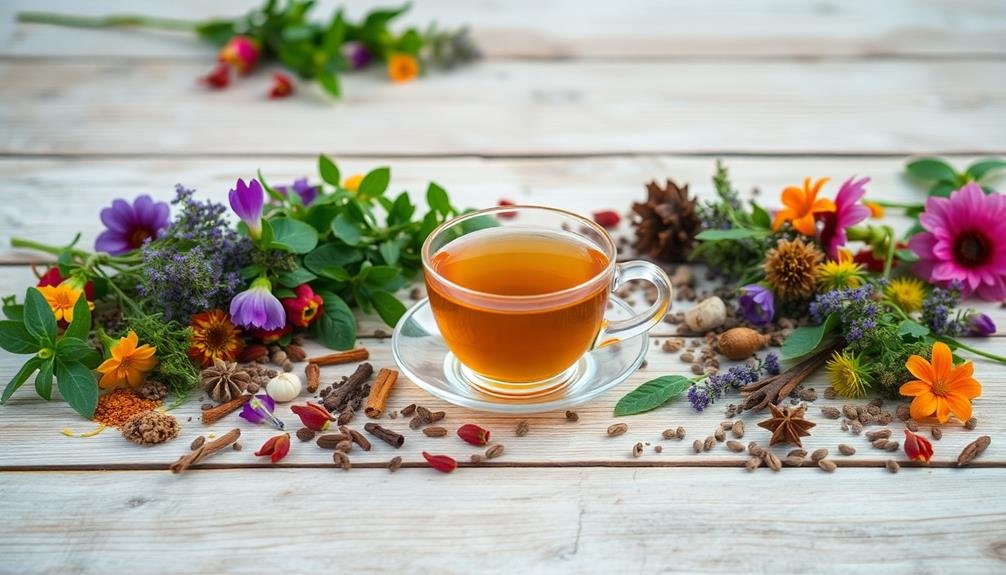
When creating herbal teas, balancing flavors is key to enhancing their benefits.
You'll want to understand the different flavor profiles and how they interact, allowing you to craft a harmonious blend.
Let's explore some effective herbal pairing techniques that will elevate your tea experience.
Flavor Profiles Explained
Herbal teas offer a delightful tapestry of flavors, each contributing to the overall experience of your brew. Understanding these flavor profiles can help you create a perfectly balanced cup. You'll find that herbal teas typically fall into four main categories: sweet, sour, bitter, and pungent.
Sweet flavors, often derived from herbs like chamomile or licorice root, create a soothing sensation. They can help soften the overall taste of your tea, making it more enjoyable.
Sour notes, found in hibiscus or lemongrass, add a revitalizing zing that can awaken your senses. These bright flavors can also aid digestion.
Bitter flavors, present in herbs like dandelion or gentian, might seem off-putting at first, but they play an important role in stimulating appetite and digestion.
Finally, pungent flavors from spices like ginger or black pepper introduce warmth and complexity, enhancing the overall profile of your tea.
When crafting your herbal blend, aim for balance by incorporating elements from each category. This harmony not only elevates your tea experience but also aligns with Ayurvedic principles, promoting well-being and enjoyment in every sip.
Herbal Pairing Techniques
Crafting a harmonious herbal tea involves more than just selecting individual ingredients; it's about understanding how different flavors interact. To achieve this balance, start by identifying the dominant flavor in your blend. Is it spicy, sweet, or earthy?
Once you know this, you can choose complementary and contrasting herbs to enhance the overall profile. For instance, if you're working with a strong mint base, consider pairing it with chamomile for a soothing touch. If your blend leans toward the earthy notes of rooibos, adding a hint of citrus from lemon verbena can brighten the mix.
Remember that balancing flavors isn't just about taste; it's also about aroma and texture. You'll want to keep in mind the potency of each herb as well. Strong herbs like ginger should be balanced with milder ones like lemongrass to avoid overpowering the blend.
Experiment with different ratios, and don't forget to brew small test batches to see how the flavors develop. With practice, you'll master the art of herbal pairing, creating teas that aren't only delicious but also nourishing for your mind and body.
Infusion Techniques
Creating the perfect herbal infusion requires attention to detail and a few simple techniques. First, you'll want to choose your base herbs wisely, as they set the foundation for flavor and benefits. Next, consider the water temperature; different herbs release their properties best at varying temperatures. Finally, steeping time is essential—too short, and you miss the benefits; too long, and the flavors become overpowering.
Here's a quick reference table to guide you through the infusion process:
| Herb Type | Water Temperature | Steeping Time |
|---|---|---|
| Leafy Herbs | 200°F (93°C) | 5-7 minutes |
| Root Herbs | 210°F (99°C) | 10-15 minutes |
| Flower Herbs | 190°F (88°C) | 3-5 minutes |
| Seed Herbs | 210°F (99°C) | 10-12 minutes |
Adjusting Ratios
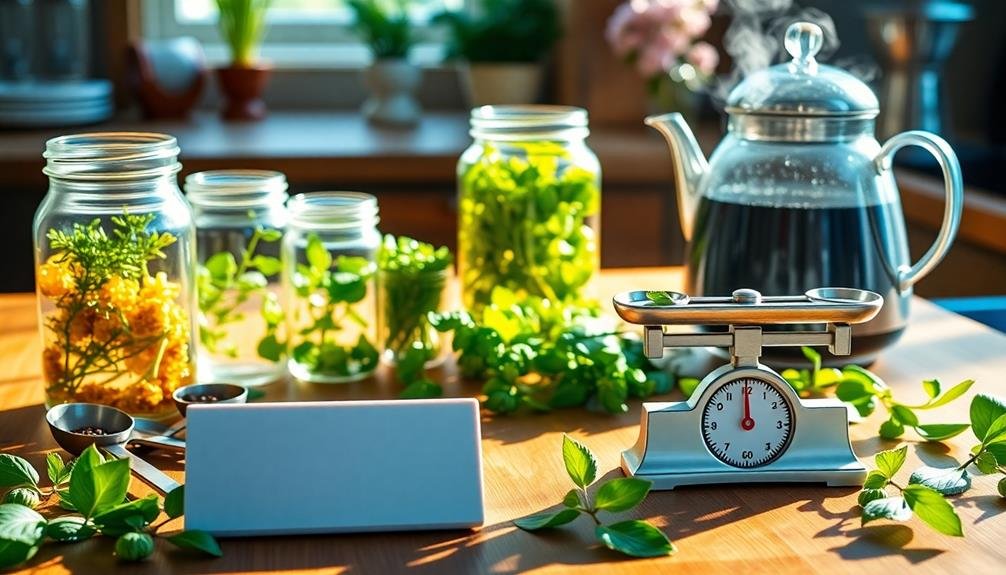
After mastering infusion techniques, adjusting the ratios of your herbs can greatly enhance the flavor and benefits of your tea.
Start by identifying the main purpose of your blend. Do you want a soothing tea for relaxation, or a revitalizing blend for energy? This will guide your choice of herbs and their proportions.
When experimenting, a good rule of thumb is to begin with a base herb that aligns with your tea's goal. For example, if you're aiming for a calming effect, use chamomile as your main herb.
Then, add complementary herbs—like lavender or lemon balm—in smaller amounts. A typical ratio might be 3 parts base herb to 1 part supporting herb.
Don't be afraid to adjust based on your taste preferences. If you find the flavor too strong or too weak, tweak the ratios accordingly.
Take notes during each trial, so you can replicate or modify your successful blends in the future.
Timing and Temperature
Timing and temperature play crucial roles in extracting the full potential of your herbal teas. If you want to enjoy the benefits of the herbs you're using, you'll need to pay attention to how long you steep them and the temperature of the water.
Each herbal ingredient has its ideal steeping time and temperature, which guarantees you capture their unique flavors and health properties.
Here are some key considerations:
- Water Temperature: Use boiling water for robust herbs like ginger or turmeric, while delicate herbs, such as chamomile or mint, require cooler water (around 190°F).
- Steeping Time: Generally, steep your herbal tea for 5 to 10 minutes. Experimenting within this range can help you find the perfect balance for your taste preferences.
- Freshness: Always use fresh herbs or high-quality dried ones. The fresher the ingredients, the more vibrant and effective your tea will be.
Personalizing Your Blend
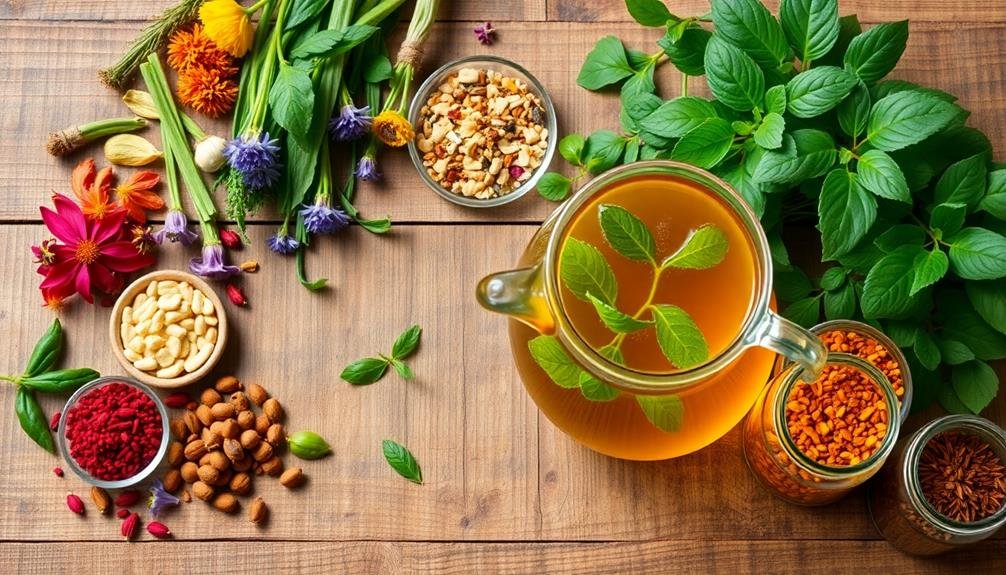
Once you've mastered the art of steeping your herbal teas, the next step is to personalize your blend to suit your unique tastes and health goals.
Start by identifying your predominant dosha—Vata, Pitta, or Kapha. This knowledge helps you select herbs that balance your constitution. For instance, if you have a Vata imbalance, contemplate warming herbs like ginger or cinnamon. If Pitta is your concern, cooling herbs like peppermint or chamomile might be more suitable.
Next, think about the flavors you enjoy. Do you prefer sweet, spicy, or earthy notes? You can mix different herbs to create a harmonious flavor profile. For example, blend rooibos for sweetness with a hint of licorice root for depth.
Don't forget to contemplate your health goals. If you're looking to boost immunity, add echinacea or elderberry. For relaxation, herbs like valerian root or lemon balm can work wonders.
Frequently Asked Questions
How Do Seasonal Changes Affect Herbal Tea Blends?
Seasonal changes influence your herbal tea blends markedly. In warmer months, you might prefer lighter, invigorating flavors, while colder months call for spicier, warming ingredients. Adjusting your blends keeps your tea experience enjoyable year-round.
Can I Use Fresh Herbs Instead of Dried Ones?
Absolutely, you can use fresh herbs instead of dried ones! Fresh herbs often provide a brighter flavor and aroma. Just remember to adjust the quantity since fresh herbs are usually more potent than their dried counterparts.
What Are the Best Storage Methods for Herbal Teas?
To store herbal teas effectively, keep them in airtight containers, away from light and moisture. Glass jars or metal tins work best. Label them with dates to guarantee freshness, and avoid excessive heat exposure.
Are There Any Contraindications for Specific Herbs?
Yes, there are contraindications for specific herbs. You should avoid certain herbs if you're pregnant, breastfeeding, or taking specific medications. Always consult a healthcare professional before using new herbs to guarantee they're safe for you.
How Can I Incorporate Herbal Teas Into My Daily Routine?
To incorporate herbal teas into your daily routine, start by selecting blends that suit your mood. Sip in the morning for energy, during breaks for relaxation, or before bed to unwind. Enjoy the ritual!
In Summary
By embracing these seven Ayurvedic principles, you can craft herbal teas that not only taste great but also nurture your body and mind. Remember to understand your dosha, select herbs thoughtfully, balance flavors, and use proper infusion techniques. Adjusting ratios and paying attention to timing and temperature will enhance your brewing experience. Most importantly, don't hesitate to personalize your blend to suit your unique needs. Enjoy the journey of discovering your perfect herbal tea!


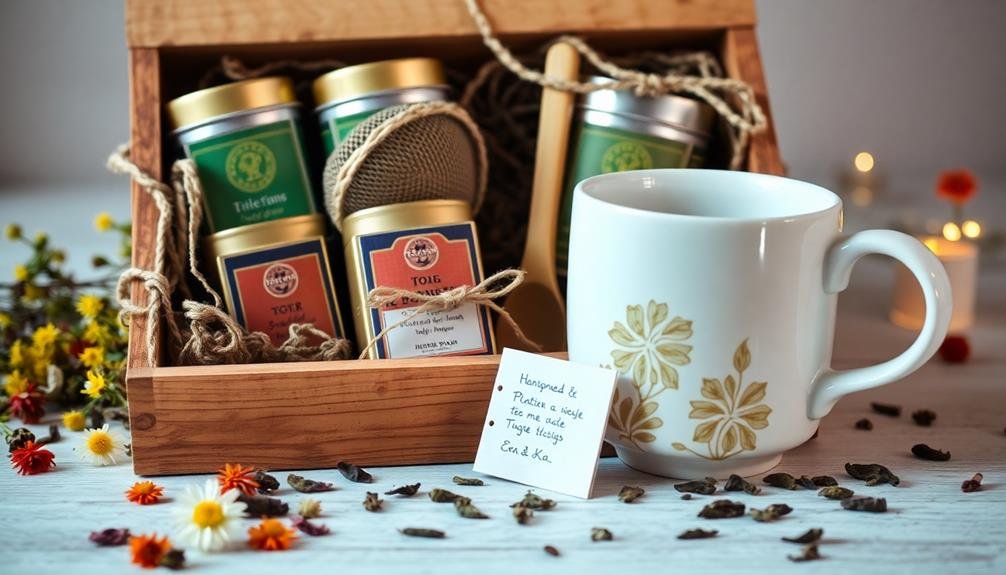
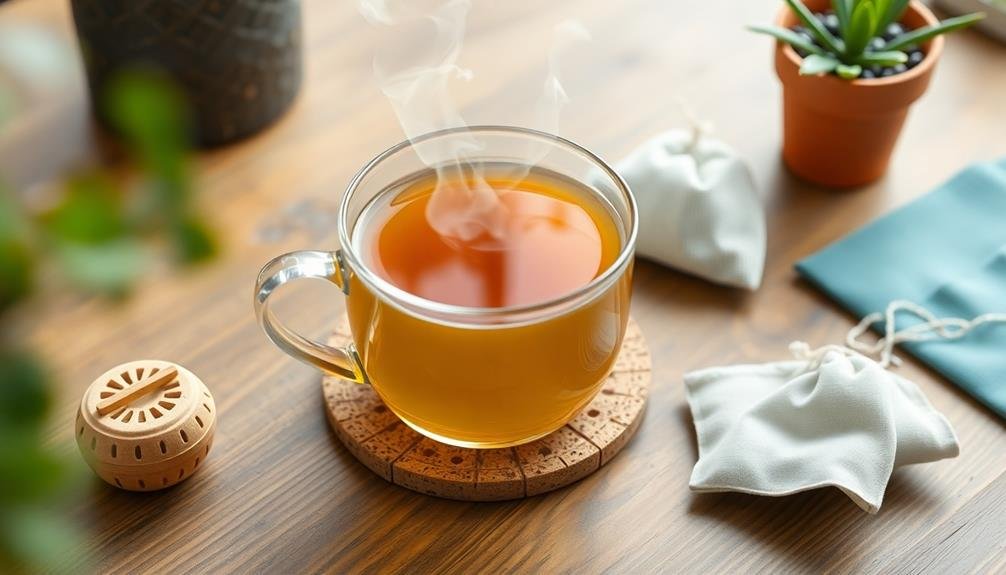
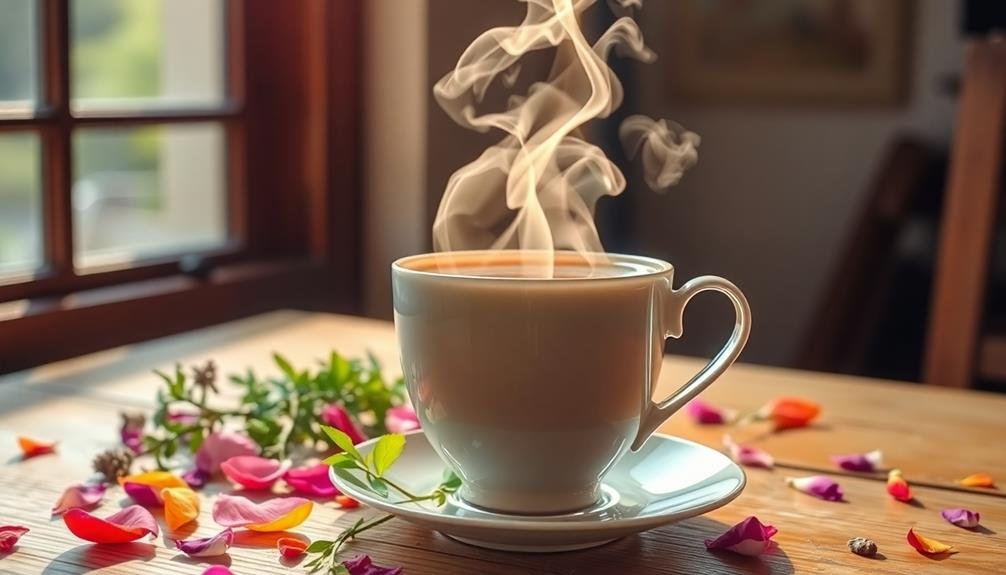
Leave a Reply